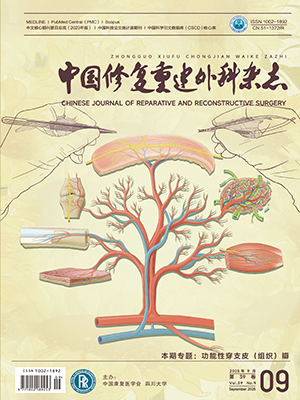| 1. |
Bishay SN. Minimally invasive single-session double-level rotational osteotomy of the forearm bones to correct fixed pronation deformity in congenital proximal radioulnar synostosis. J Child Orthop, 2016, 10(4): 295-300.
|
| 2. |
Kepenek-Varol B, Hoşbay Z. Is short-term hand therapy effective in a child with congenital radioulnar synostosis? A case report. J Hand Ther, 2019. [Epub ahead of print].
|
| 3. |
Nakasone M, Nakasone S, Kinjo M, et al. Three-dimensional analysis of deformities of the radius and ulna in congenital proximal radioulnar synostosis. J Hand Surg (Eur Vol), 2018, 43(7): 739-743.
|
| 4. |
Shingade VU, Shingade RV, Ughade SN. Results of single-staged rotational osteotomy in a child with congenital proximal radioulnar synostosis: subjective and objective evaluation. J Pediatr Orthop, 2014, 34(1): 63-69.
|
| 5. |
Garg G, Gupta SP. Surgical outcome of delayed presentation of congenital proximal radioulnar synostosis. SICOT J, 2015, 1: 33.
|
| 6. |
Pei X, Han J. Efficacy and feasibility of proximal radioulnar derotational osteotomy and internal fixation for the treatment of congenital radioulnar synostosis. J Orthop Surg Res, 2019, 14(1): 81.
|
| 7. |
Horii E, Koh S, Hattori T, et al. Single osteotomy at the radial diaphysis for congenital radioulnar synostosis. J Hand Surg (Am), 2014, 39(8): 1553-1557.
|
| 8. |
Sakamoto S, Doi K, Hattori Y, et al. Modified osteotomy (Kanaya’s procedure) for congenital proximal radioulnar synostosis with posterior dislocation of radial head. J Hand Surg (Eur Vol), 2014, 39(5): 541-548.
|
| 9. |
Kanaya K, Iba K, Yamashita T. Long-term results after a free vascularized adipofascial graft for congenital proximal radioulnar synostosis with an average follow-up of 10 years: a series of four cases. J Shoulder Elbow Surg, 2016, 25(8): 1258-1267.
|
| 10. |
Cleary JE, Omer GE Jr. Congenital proximal radio-ulnar synostosis. Natural history and functional assessment. J Bone Joint Surg (Am), 1985, 67(4): 539-545.
|
| 11. |
Farzan M, Daneshjou Kh, Mortazavi SMJ, et al. Congenital radioulnar synostosis: A report of 11 cases and review of literature. Acta Medica Iranica, 2002, 40(2): 126-131.
|
| 12. |
Hung NN. Derotational osteotomy of the proximal radius and the distal ulna for congenital radioulnar synostosis. J Child Orthop, 2008, 2(6): 481-489.
|
| 13. |
陈文, 王体沛, 邢敦凯, 等. 尺桡骨中段旋转截骨术治疗先天性上尺桡关节融合及并发症探讨. 中华小儿外科杂志, 2006, 27(4): 194-196.
|
| 14. |
Hwang JH, Kim HW, Lee DH, et al. One-stage rotational osteotomy for congenital radioulnar synostosis. J Hand Surg (Eur Vol), 2015, 40(8): 855-861.
|
| 15. |
Dal Monte A, Andrisano A, Mignani G, et al. A critical review of the surgical treatment of congenital proximal radio-ulnar synostosis. Ital J Orthop Traumatol, 1987, 13(2): 181-186.
|
| 16. |
Miura T, Nakamura R, Suzuki M, et al. Congenital radio-ulnar synostosis. J Hand Surg Br, 1984, 9(2): 153-155.
|
| 17. |
Kanaya F. Mobilization of congenital proximal radio-ulnar synostosis: a technical detail. Tech Hand Up Extrem Surg, 1997, 1(3): 183-188.
|
| 18. |
Funakoshi T, Kato H, Minami A, et al. The use of pedicled posterior interosseous fat graft for mobilization of congenital radioulnar synostosis: a case report. J Shoulder Elbow Surg, 2004, 13(2): 230-234.
|
| 19. |
黄娜, 文辉才, 付建华, 等. 改良菱形皮瓣在面部皮肤软组织缺损修复中的应用. 中国修复重建外科杂志, 2019, 33(2): 207-211.
|




